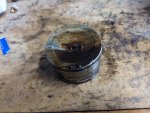- 276
- 538
- 93
- Location
- switzerland
Moin together
Short history. My M1123 is from Barstow and was overhauled in 2009. After that it was in the desert and I got it with 2'000mi.
For the TÜV a brake force regulator had to go in. The rear axle had over braked too much.
Now the good man, who mechanically delivered a clean performance, but filled up DOT3.
In the truck itself is emblazoned inside the and front of the "Silicone only" sticker.
I wrote him that in the hope he had written DOT3 on the bill out of habit. But no, he has used DOT3, so glycol based.
But now comes what makes me either suspicious or angry.
He wants to tell me now that the vehicles are converted to glycol based, so DOT3/DOT4 at the revision in Barstow.
This can be seen on the "spindle inspected" sticker.
But this makes no sense to me! On the one hand, the spindle has nothing to do with the brake and secondly, this would be completely new to me and thirdly, there comes for me the logic ...
The truck was painted once in Barstow. And after that the military knowingly put the wrong stickers in the truck?! The "everything according to manual" military? Did the old stickers still have to be used up?
There is something wrong... can one of you say something about the situation?
Thank you & best regards,
Gerd
Quote:
"it was again not easy to obtain the appropriate information. It behaves as follows:
If one of these vehicles has been overhauled; as in your case, a conversion takes place. The brake system is converted whereby all components are exchanged in which rubber seals are installed. After the conversion. DOT 3 or 4 is prescribed. DOT 3 has a lower boiling point than DOT 4, but in all probability you will never reach it with your vehicle. Furthermore, DOT 3 is in contrast to DOT 4 chemically less aggressive, which is rather beneficial to the entire brake system.
All vehicles on which the conversion has been done can be recognized by the sticker "Spindle's inspected." This is the inspection you have described.
You can find it at the following position on your car: picture of my car from the front.
End quote
Short history. My M1123 is from Barstow and was overhauled in 2009. After that it was in the desert and I got it with 2'000mi.
For the TÜV a brake force regulator had to go in. The rear axle had over braked too much.
Now the good man, who mechanically delivered a clean performance, but filled up DOT3.
In the truck itself is emblazoned inside the and front of the "Silicone only" sticker.
I wrote him that in the hope he had written DOT3 on the bill out of habit. But no, he has used DOT3, so glycol based.
But now comes what makes me either suspicious or angry.
He wants to tell me now that the vehicles are converted to glycol based, so DOT3/DOT4 at the revision in Barstow.
This can be seen on the "spindle inspected" sticker.
But this makes no sense to me! On the one hand, the spindle has nothing to do with the brake and secondly, this would be completely new to me and thirdly, there comes for me the logic ...
The truck was painted once in Barstow. And after that the military knowingly put the wrong stickers in the truck?! The "everything according to manual" military? Did the old stickers still have to be used up?
There is something wrong... can one of you say something about the situation?
Thank you & best regards,
Gerd
Quote:
"it was again not easy to obtain the appropriate information. It behaves as follows:
If one of these vehicles has been overhauled; as in your case, a conversion takes place. The brake system is converted whereby all components are exchanged in which rubber seals are installed. After the conversion. DOT 3 or 4 is prescribed. DOT 3 has a lower boiling point than DOT 4, but in all probability you will never reach it with your vehicle. Furthermore, DOT 3 is in contrast to DOT 4 chemically less aggressive, which is rather beneficial to the entire brake system.
All vehicles on which the conversion has been done can be recognized by the sticker "Spindle's inspected." This is the inspection you have described.
You can find it at the following position on your car: picture of my car from the front.
End quote





